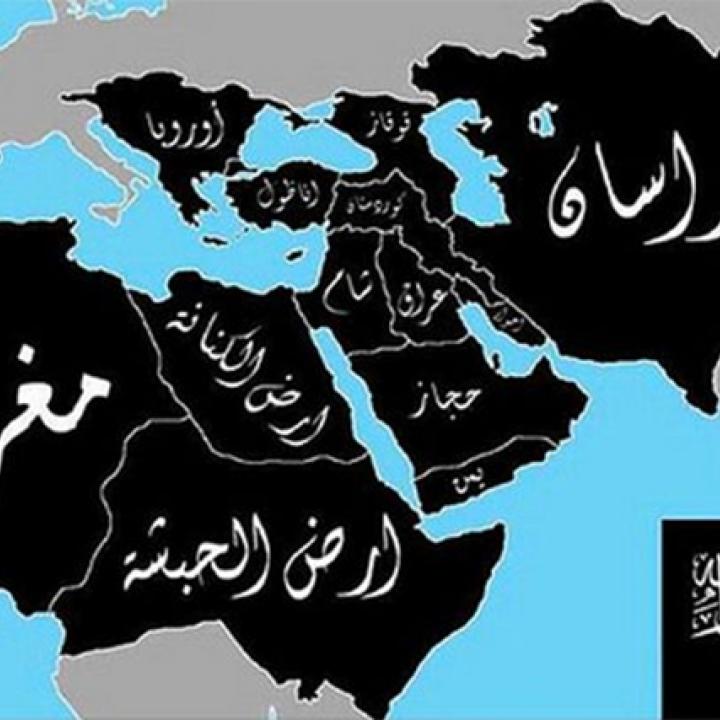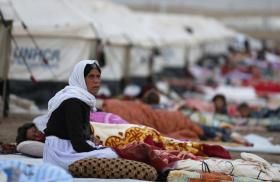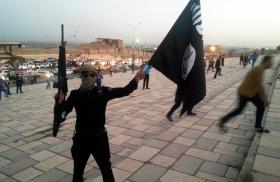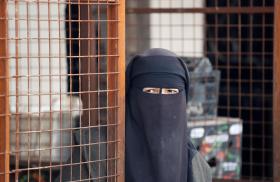
- Policy Analysis
- PolicyWatch 2522
The Rise of ISIS: 'Remaining and Expanding'

Part of a series: Counterterrorism Lecture Series
or see Part 1: U.S. Efforts against Terrorism Financing: A View from the Private Sector
Read or an in-depth conversation on the fifteen-year history of ISIS and its predecessor groups, and the potential future of the so-called 'Islamic State,' with three leading scholars of jihadist terrorism.
On November 4, Joby Warrick, Will McCants, and Aaron Zelin addressed a Policy Forum at The Washington Institute. Warrick has covered national security, intelligence, and the Middle East for the Washington Post since 1996. McCants is a fellow at the Center for Middle East Policy and director of the Project on U.S. Relations with the Islamic World at the Brookings Institution. Zelin is the Institute's Richard Borow Fellow and founder of the website Jihadology.net. The following is a rapporteur's summary of their remarks.
JOBY WARRICK
Abu Musab al-Zarqawi was an indispensable force in the formation and leadership of al-Qaeda in Iraq (AQI), the predecessor to ISIS, and he continues to influence those faithful to his vision and tactics long after his 2006 death in a U.S. airstrike. Through charisma and shocking displays of violence, he brought together disaffected former Baathists and radical Islamists to start an effective insurgency against the U.S. occupation in Iraq.
During his time in Jordanian prison in the 1990s, Zarqawi was radicalized and transformed himself from a street thug into a leader. He cultivated a tough and fearless persona, which attracted followers and gave him sway over more experienced and educated inmates. When he tried to join al-Qaeda in Afghanistan following his early release in 1999, Osama bin Laden considered him too radical for the group.
Indeed, Zarqawi had significant differences with bin Laden regarding al-Qaeda's objectives and strategy. Zarqawi had no interest in appealing to all Muslims. When planning his strategy in Iraq, he saw an opportunity to garner Sunni support by exploiting sectarian tensions and creating a firestorm. His recruitment efforts were aided when Colin Powell mistakenly cited him as a link between al-Qaeda and Saddam Hussein, earning him fame and followers.
Zarqawi's first targets in Iraq were embassies, the UN, NGOs, and Shiite leaders, with the aim of isolating each party and forcing the United States to stand in the middle of the resultant sectarian war. His goal was not to liberate Iraq but to push Sunnis into creating a theocratic state. He dismissed claims from al-Qaeda leaders and elsewhere that Sunnis were not ready for their own state.
Instead of al-Qaeda's prolix proselytism, Zarqawi distributed violent videos to attract radical Muslims. He recognized that execution videos can have greater propaganda value than mass-casualty bombings. His efforts were aided by former Iraqi military officers who were experienced in operating security apparatuses; he maintained a formidable intelligence and supply network in Iraq and eluded U.S. forces for over two years.
While al-Qaeda focused on Islam's far enemy, Zarqawi aimed for the near enemy -- local states and rulers -- with the goal of reestablishing the Caliphate by garnering large-scale Sunni support. Eight years after Zarqawi's death, Abu Bakr al-Baghdadi publicly declared the fulfillment of this goal in a Mosul mosque, and his announcement paid tribute to Zarqawi, not bin Laden.
Since then, the so-called Islamic State has shown skill at collecting revenue. Even during the 2009 nadir of its AQI predecessor, the group still raised $200-250 million per annum, almost exclusively from kidnapping and extortion. Today, as ISIS adds territory, it gains more revenue from taxes, oil, antiquities, and the slave trade. One potential difficulty might arise if pensions for the families of fighters killed on the battlefield become an unsustainable financial burden. Such factors obligate ISIS to continually expand its tax base. Yet its self-financing mechanisms are difficult to disrupt.
As for the potential emergence of a Sunni "Awakening" that could challenge its hold on territory, ISIS is cognizant of the threat and broadcasts harsh punishments as a deterrent against would-be conspirators. While U.S. forces under Gen. Stanley McChrystal were successful with targeted killing operations against AQI in the past, that option is not available against ISIS. Rather, Sunnis are the center of gravity in any strategy to defeat the group.
WILL MCCANTS
Prior to the Iraq war, Zarqawi conceived of establishing the Islamic State as the nucleus of a caliphate, and he viewed the subsequent conflict as the best opportunity for realizing his ambition. This strategy set him apart from other jihadist organizations that regarded the United States as their primary enemy.
While Zarqawi lacked a sophisticated political vision, other theorists provided a framework for his state-building project. In 2004, an al-Qaeda member wrote Management of Savagery, a blueprint for creating a theocratic state. It detailed how jihadis should exploit existing security vacuums or create their own by attacking sensitive state infrastructure. Once the state receded in order to consolidate and regroup, jihadis could enter the vacuum to provide social services and security. These jihadi-governed spaces could then network with each other and establish a state. Abu Bakr al-Baghdadi's 2014 declaration of a caliphate was the first such plausible claim since the fall of the Ottoman Empire.
The key to this strategy is attracting local Sunni support -- an issue that proved to be a crucial difference between al-Qaeda and Zarqawi's AQI. The central leadership considered winning hearts and minds necessary to bolstering their political program, while Zarqawi believed in acting with clear purpose, precision, and violence to either gain Sunni support or force Sunni submission to his objectives. Al-Qaeda advised against this hurried approach to state building -- Zarqawi's tactics angered Sunni tribes and rebel groups, and their discontent was empowered and channeled by the U.S. military presence in Iraq, which led to the undoing of the first Islamic State project in 2008-2009. By then, the movement had been degraded from a viable insurgency to a clandestine terrorist organization.
After this setback, however, al-Qaeda affiliates adopted the ISIS flag and state-building project in spaces where the Iraqi state was collapsing or absent. And beginning in 2012, the Syrian civil war provided additional opportunities for the group. Many Sunni Arab tribes felt disenfranchised and were willing to assist ISIS because they saw it as a preferable alternative to either the Assad regime or an increasingly Shiite-dominated Iraqi state. Initially, ISIS collaborated with other factions in these spaces, but over time it sought to impose its agenda and eliminate rivals.
In the end, the organization's fate will probably be similar to that of other jihadi "states," all of which crumbled. Yet these states did not fail because of poor governance or excessive brutality, but rather because they attracted powerful and determined foreign enemies. While ISIS has made many enemies in Iraq and Syria, most of them are currently focused on other priorities. And although its continued efforts to conquer all Muslim lands will earn it further enemies, the ongoing unrest in the region and the lack of will among those who would oppose it may allow ISIS to spread. The group does acknowledge certain limits, however -- it knows it cannot advance toward Mecca or Jerusalem at present.
In sum, the past U.S. approach during Iraq's Anbar Awakening also holds the key to defeating ISIS today. Sunni Arab tribal support needs to be the focal point in any strategy to counter the group -- a prerequisite that necessarily excludes Iran and Russia from any viable anti-ISIS coalition.
AARON ZELIN
ISIS has a pattern for expanding, developing, and consolidating power. While this was initially an ad hoc process, it is now conducted systematically, and this bureaucratization allows ISIS to act consistently across different provinces and between core and periphery territories. While some steps occur simultaneously, it is mostly a linear progression: intelligence operations, followed by military operations, dawa (missionary) activities, hisba activities (moral policing and consumer protection), and governance.
The intelligence phase includes arranging sleeper cells and infiltrating different groups. In territories like the Sinai, Libya, and Syria, ISIS does not start from scratch, instead incorporating existing jihadi networks under its flag, allowing the group to quickly learn the local terrain. ISIS then employs asymmetric militant tactics such as hit-and-run attacks and car bombs. "Missionary" activities -- including propaganda viewing parties and the distribution of electronic ID cards -- allow the group to inform its subject populations, guide public discourse, and unify its cadres. Public relations offices are established to bring feuding parties together and handle arbitration, while hisba activities include burning banned items and non-Sunni religious symbols. ISIS then introduces taxes, greater regulation, and social services. Currently, the group's largest source of revenue is confiscated property, but this is unsustainable in the long term.
ISIS lacks full control in most areas, but it is working to achieve a level of normalcy throughout its territory. Black flags are ubiquitous, some areas have been renamed, and public works projects show that the group is providing for the local population. It has also restarted many industries such as water treatment, agriculture, and commodity production.
ISIS authorities have remained vigilant against the dangers of potential "Awakenings," suppressing three so far in Iraq, Libya, and Deir al-Zour, Syria. They strictly monitor the Internet and media, and after establishing control in an area, they conduct reeducation programs for local leaders and citizens. They also use entrapment to root out opposition. While some individuals in ISIS-controlled territory adhere to the group's cause, others remain silent solely to stay alive. Once the group is entrenched, it is difficult to deracinate, though its control is less firm in Syria than in Iraq. The only territories ISIS has forfeited are those where it never established full control.
Finally, while ISIS has a near-enemy focus at the moment, it could eventually use its territory as a safe haven to launch a large-scale foreign terrorist operation similar to the September 11 attacks, with the goal of gaining followers and assuming al-Qaeda's mantle.
This summary was prepared by Patrick Schmidt.








